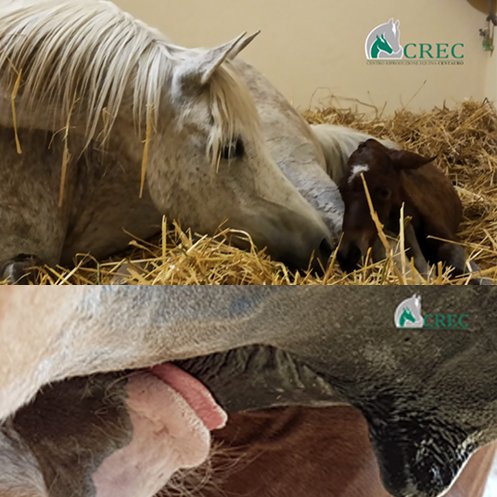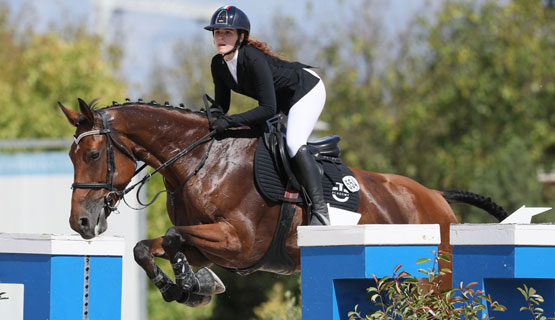THE BIRTH AND THE FIRST HOURS OF LIFE
22.04.20
0 Comments

As anticipated in the previous article "Management of the pregnant mare", the duration of the gestation of the mare can depend on several factors that we report below:
- age of the mare,
- period of the year in which the expected date of delivery takes place,
- primipara or pluripara horse (1st birth or one that has already given birth other times in its life),
- pathologies affecting the mare or pathologies affecting the gestation itself (e.g. placental), - feeding / status of the mare,
-individual factors.
Childbirth is certainly a delicate phase; is the culmination of the efforts sustained by both the mare and the owner and it is therefore appropriate to prepare adequately to carefully follow both the birth phase and the first hours of life of the foal, important for the early diagnosis of some pathologies that can seriously danger the life of the unborn child.
PREMONITORY SIGNS OF THE BIRTH
The first way to prepare for childbirth is to constantly monitor the mare to detect the warning signs of an imminent birth. Among these we mention:
- An enlarged breast
- Appearance at the level of the nipple of crystallized secretions similar to "beads"
- Relaxation of the ligaments of the pelvis with consequent loss of firmness of the croup.
- Colic-like symptoms during labor. The stage of labor is subjective and can last from a few minutes to several hours.
If the mare is near childbirth, provide her with a box where she can give birth in peace and remember that most of the births take place during the night. Warn your veterinarian when the mare is near farrowing.
CHILDBIRTH
What happens during childbirth?
With the presentation of the pains associated with labor, the mare is generally unappetizing and continues to show signs of discomfort (turns in the box, rasp, sweats, etc.) until the waters break and an obvious spill of physiologically clear liquids occurs. from the vulva.
Once the mare has broken the waters, no more than 20 minutes must pass from the foal's escape, an extension of this time will in fact jeopardize the viability of the unborn child.
A foal in a cranial position will present itself with the head between the two front limbs, one of which is further back than the other.
This is certainly not the place to talk about it, but we remember that during the birth, misalignments can become manifest and in these cases, without a repositioning of the foal, the mare will not be able to complete the birth, endangering both her life and that of the unborn child; therefore immediately call a veterinarian if the mare is unable to complete the expulsion phase.
What to do after completing the birth? Let's consider the foal first and then the mother.
THE FIRST HOURS OF LIFE OF THE FOAL
Once the birth has been completed, make sure the foal breathes properly; breathing can be stimulated by rubbing towels on the foal's chest and freeing the nostrils from placental fluids. To assess the foal's responsiveness, its ears can be tickled with a straw stem.
After drying the foal, disinfect the navel well with diluted disinfectant and repeat the operation if necessary. Also perform rectal enemas to facilitate the expulsion of meconium and reduce the risk of any constipation. As enemas we can use the commercial ones commonly sold in pharmacies. This operation must also be repeated in the event that the foal does not expel meconium easily (meconium is the stool accumulated during pregnancy characterized by a dark brown color and a firmer consistency of the subsequent milk feces which are yellow and soft). Contact the vet if the foal cannot get rid of the meconium easily.
After doing these first steps, let the mother and foal interact with each other.
The foal will begin to make attempts to get up until it manages to hire a quad station (in case of prolonged difficulty we can help it) and will look for the udder. In this regard it is important to remember that the intake of colostrum from the mother must take place in a fairly limited time range both because with the passing of the hours the quality of the colostrum will decrease and because the foal's intestine, only in the first hours of life, has the ability to absorb colostral antibodies (essential for the immune defenses of the first months). All this to emphasize that if the foal has not become attached within 3 hours, it must be helped by directing it towards the breast or through the use of bottles / bowls; attention the bottle must be given in the correct way otherwise you risk making milk go into the lungs. In this case, consult your veterinarian to decide how to proceed.
We recommend carrying out blood tests 24 hours after birth to quantify the antibodies taken with colostrum and to evaluate the presence of pathologies that are not yet clinically manifest through the blood count. The results of the analyzes will be useful for early diagnosis of the progress of some diseases and, the measurement of the antibodies, it will be important to understand if the passage of maternal immunity has taken place successfully or if instead, the foal will need a supplement through the administration of hyperimmune plasma.
THE MOTHER
As for the mare, however, special attention must be paid to the expulsion of the placenta. This must take place within 6 hours of delivery, after which we will talk about retention of fetal involutions, a situation that can lead to the onset of infections localized to the uterus with consequent septicemia. In this case, urgently call a veterinarian who will have to remove all the placenta. If, on the other hand, the mare has expelled the placenta, check that it has been fully expelled and, if necessary, keep it in a bucket in a closed and cool environment so that it can be evaluated by the veterinarian the next day.
To conclude, it is recommended, especially if you decide to give birth to the mare at home, to equip yourself properly before giving birth. Prepare a box where you can put the mare when the gestation deadline approaches, get everything you need for when the foal will be born: clean towels, diluted disinfectant (to be able to disinfect the navel), an enema (of those found in pharmacy) to facilitate the expulsion of meconium. Even if everything seems to have gone well, it is still advisable to have the foal visited by a veterinary surgeon the day after birth, to make sure that everything is normal and possibly make an analysis to evaluate the blood parameters and especially the passage of the antibodies from mother to foal.

.png)

Leave your comment